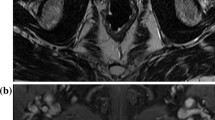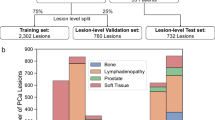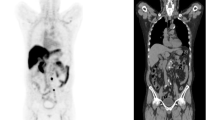Abstract
Purpose
To assess the utility of convoluted neural network (CNN) in differentiating clinically significant and insignificant prostate cancer in patients with 68 Ga PSMA PET/CT-targeted prostate biopsy-proven prostate cancer.
Methods
In this retrospective study, 142 patients with clinical suspicion of prostate cancer were evaluated who underwent 68 Ga-PSMA PET/CT imaging followed by 68 Ga-PSMA PET/CT-targeted prostate biopsy from the PSMA-avid prostate lesion. Twenty patients with no PSMA-avid lesions were excluded. Local Image Features Extraction (LifeX) software was used to extract radiomic features (RF) from delayed 68 Ga-PSMA PET/CT images of 122 patients. LifeX failed to extract radiomic features in 24 patients, and the remaining 98 were evaluated. RFs were fed to an in-built CNN of the software for computation and results were achieved. Patients with Gleason Score ≥ 7 on histopathology were labeled clinically significant prostate cancer (csPCa). The diagnostic values of radiomic features were evaluated.
Results
The csPCa was revealed in 69/98 (70.4%) patients, and insignificant PCa was noticed in 29/98 (29.6%) patients. The software extracted 124 RF from the delayed 68 Ga-PSMA PET/CT images. The accuracy of the CNN was 80.7% to differentiate clinically significant and clinically insignificant prostate cancer, with an error percentage (E %) of 19.3%. The sensitivity, specificity, positive predictive, and negative predictive values were 90.3%, 57.7%, 83.6%, and 71.4%, respectively, to detect csPCa.
Conclusion
CNN is a feasible pre-biopsy screening tool for identifying clinically significant prostate cancer and can be used as an adjunct in the initial diagnosis and early treatment planning.






Similar content being viewed by others
Data Availability
Data generated and analyzed can be availed from the corresponding author on a reasonable request.
References
Culp MBB, Soerjomataram I, Efstathiou JA, Bray F, Jemal A. Recent global patterns in prostate cancer incidence and mortality rates. Eur Urol. 2020;77:38–52.
Hariharan K, Padmanabha V. Demography and disease characteristics of prostate cancer in India. Indian J Urol. 2016;32:103–8.
Becopoulos T. Clinically significant and non significant prostate cancer an ongoing question. Acta Chir Iugosl. 2005;52:27–9.
Osmany S, Zaheer S, Bartel TB, Johnston M, Peh WM, Barmaky S, Jadvar H. Gallium-68-labeled prostate-specific membrane antigen-11 PET/CT of prostate and nonprostate cancers. AJR Am J Roentgenol. 2019;213:286–99.
Fendler WP, Eiber M, Beheshti M, Bomanji J, Ceci F, Cho S, et al. 68Ga-PSMA PET/CT: joint EANM and SNMMI procedure guideline for prostate cancer imaging: version 1.0. Eur J Nucl Med Mol Imaging. 2017;44:1014–24.
Kumar R, Singh SK, Mittal BR, Vadi SK, Kakkar N, Singh H, et al. Safety and diagnostic yield of 68Ga prostate-specific membrane antigen PET/CT guided robotic-assisted transgluteal prostatic biopsy. Radiology. 2022;303:392–8.
Cuocolo R, Cipullo MB, Stanzione A, Ugga L, Romeo V, Radice L, et al. Machine learning applications in prostate cancer magnetic resonance imaging. Eur Radiol Exp. 2019;3:35.
Yoo S, Gujrathi I, Haider MA, Khalvati F. Prostate cancer detection using deep convolutional neural networks. Sci Rep. 2019;9:19518.
Hatt M, Tixier F, Pierce L, Kinahan PE, Le Rest CC, Visvikis D. Characterization of PET/CT images using texture analysis: the past, the present… any future? Eur J Nucl Med Mol Imaging. 2017;44:151–65.
Zamboglou C, Carles M, Fechter T, Kiefer S, Reichel K, Fassbender TF, et al. Radiomic features from PSMA PET for non-invasive intraprostatic tumor discrimination and characterization in patients with intermediate- and high-risk prostate cancer - a comparison study with histology reference. Theranostics. 2019;9:2595–605.
El Naqa I, Grigsby P, Apte A, Kidd E, Donnelly E, Khullar D, et al. Exploring feature-based approaches in PET images for predicting cancer treatment outcomes. Pattern Recognit. 2009;42:1162–71.
Sa R, Zhao HG, Dai YY, Guan F. The role of dual time point PET/CT for distinguishing malignant from benign focal 18F-FDG uptake duodenal lesions. Medicine (Baltimore). 2018;97: e12521.
Nioche C, Orlhac F, Boughdad S, Reuzé S, Goya-Outi J, Robert C, et al. LIFEx: a freeware for radiomic feature calculation in multimodality imaging to accelerate advances in the characterization of tumor heterogeneity. Cancer Res. 2018;78:4786–9.
MATLAB. 9.9.0.1467703 (R2010b). Natick, Massachusetts: The MathWorks Inc. 2020.
Yao S, Jiang H, Song B. Radiomics in prostate cancer: basic concepts and current state-of-the-art. Chin J Acad Radiol. 2020;2:47–55.
Chaddad A, Kucharczyk MJ, Niazi T. Multimodal radiomic features for the predicting Gleason Score of prostate cancer. Cancer (Basel). 2018;10:249.
Wang X, Yang W, Weinreb J, Han J, Li Q, Kong X, et al. Searching for prostate cancer by fully automated magnetic resonance imaging classification: deep learning versus non-deep learning. Sci Rep. 2017;7:15415.
Lin H, Si J, Abousleman G. P. Region-of-interest detection and its application to image segmentation and compression. 2007 International Conference on Integration of Knowledge Intensive Multi-Agent Systems, KIMAS; 2007:306–11.
Mehrtash A, Sedghi A, Ghafoorian M, Taghipour M, Tempany CM, Wells WM 3rd, et al. Classification of clinical significance of MRI prostate findings using 3D convolutional neural networks. Proc SPIE Int Soc Opt Eng. 2017;10134:101342A.
Syafeeza AR, Khalil-Hani M, Imran H, Ibrahim MM, Wong YC. Generalizing convolutional neural networks for pattern recognition tasks. ARPN J Eng Appl Sci. 2015;10:5298–308.
Geman S, Bienenstock E, Doursat R. Neural networks and the bias/variance dilemma. Neural Comput. 1992;4:1–58.
Czernin J, Allen-Auerbach M, Nathanson D, Herrmann K. PET/CT in oncology: current status and perspectives. Curr Radiol Rep. 2013;1:177–90.
Gao J, Zhang C, Zhang Q, Fu Y, Zhao X, Chen M, Zhang B, et al. Diagnostic performance of 68Ga-PSMA PET/CT for identification of aggressive cribriform morphology in prostate cancer with whole-mount sections. Eur J Nucl Med Mol Imaging. 2019;46:1531–41.
Bailey J, Piert M. Performance of 68Ga-PSMA PET/CT for prostate cancer management at initial staging and time of biochemical recurrence. Curr Urol Rep. 2017;18:84–90.
Budäus L, Leyh-Bannurah SR, Salomon G, Michl U, Heinzer H, Huland H, et al. Initial experience of 68Ga-PSMA PET/CT imaging in high-risk prostate cancer patients prior to radical prostatectomy. Eur Urol. 2016;69:393–6.
Kumar R, Mittal BR, Bhattacharya A, Singh H, Bal A, Vadi SK, et al. Diagnostic performance of real-time robotic arm-assisted 18 F-FDG PET/CT-guided percutaneous biopsy in metabolically active abdominal and pelvic lesions. Eur J Nucl Med Mol Imaging. 2019;46:838–47.
Kumar R, Mittal BR, Bhattacharya A, Vadi SK, Singh H, Bal A, et al. Positron emission tomography/computed tomography guided percutaneous biopsies of Ga-68 avid lesions using an automated robotic arm. Diagn Interv Imaging. 2020;101:157–67.
Huang YE, Chen CF, Huang YJ, Konda SD, Appelbaum DE, Pu Y. Interobserver variability among measurements of the maximum and mean standardized uptake values on 18F-FDG PET/CT and measurements of tumor size on diagnostic CT in patients with pulmonary tumors. Acta Radiol. 2010;51:782–8.
Author information
Authors and Affiliations
Contributions
All authors have made a significant contribution in formulating, reviewing, and editing the manuscript.
Corresponding author
Ethics declarations
Competing Interests
Rajender Kumar, Arivan Ramachandran, Bhagwant Rai Mittal and Harmandeep Singh declare no competing interests.
Ethics Approval and Consent to Participate
This study was performed in accordance with the ethical standards as laid down in the 2013 Declaration of Helsinki and its later amendments or comparable ethical standards. The institutional review board waived the requirement for written consent.
Consent for Publication
Informed consent was obtained from the participant for the study mentioned as a part of the institutional protocol.
Additional information
Publisher's Note
Springer Nature remains neutral with regard to jurisdictional claims in published maps and institutional affiliations.
Supplementary Information
Below is the link to the electronic supplementary material.
Rights and permissions
Springer Nature or its licensor (e.g. a society or other partner) holds exclusive rights to this article under a publishing agreement with the author(s) or other rightsholder(s); author self-archiving of the accepted manuscript version of this article is solely governed by the terms of such publishing agreement and applicable law.
About this article
Cite this article
Kumar, R., Ramachandran, A., Mittal, B.R. et al. Convoluted Neural Network for Detection of Clinically Significant Prostate Cancer on 68 Ga PSMA PET/CT Delayed Imaging by Analyzing Radiomic Features. Nucl Med Mol Imaging 58, 62–68 (2024). https://doi.org/10.1007/s13139-023-00832-3
Received:
Revised:
Accepted:
Published:
Issue Date:
DOI: https://doi.org/10.1007/s13139-023-00832-3




